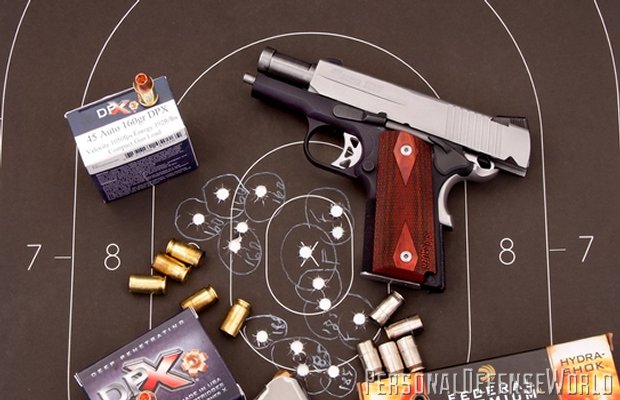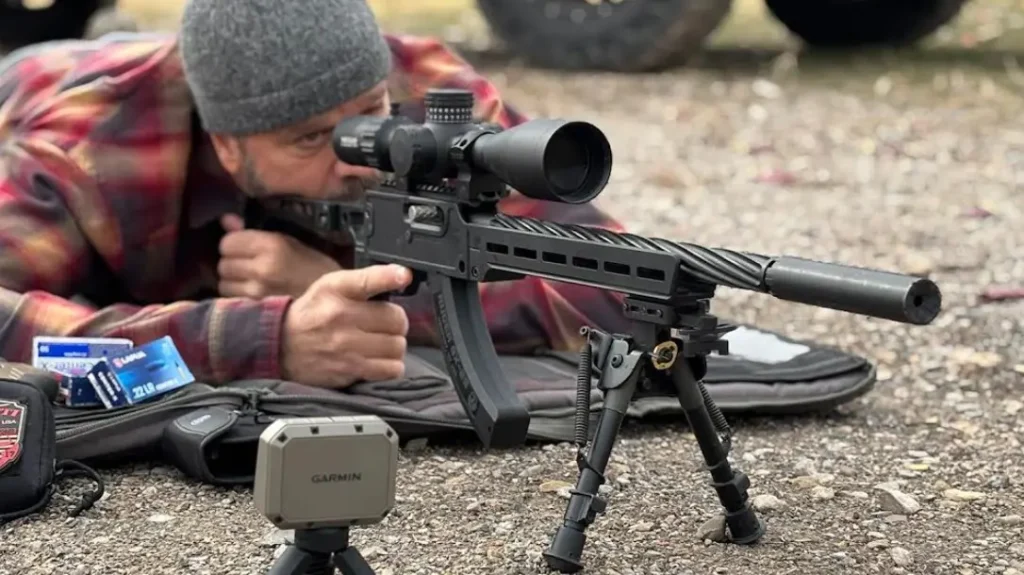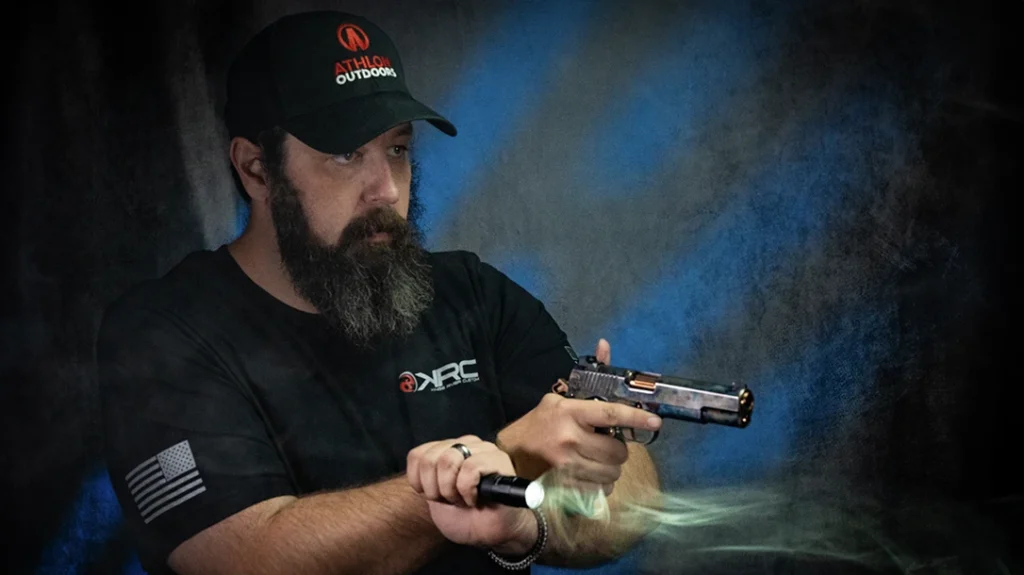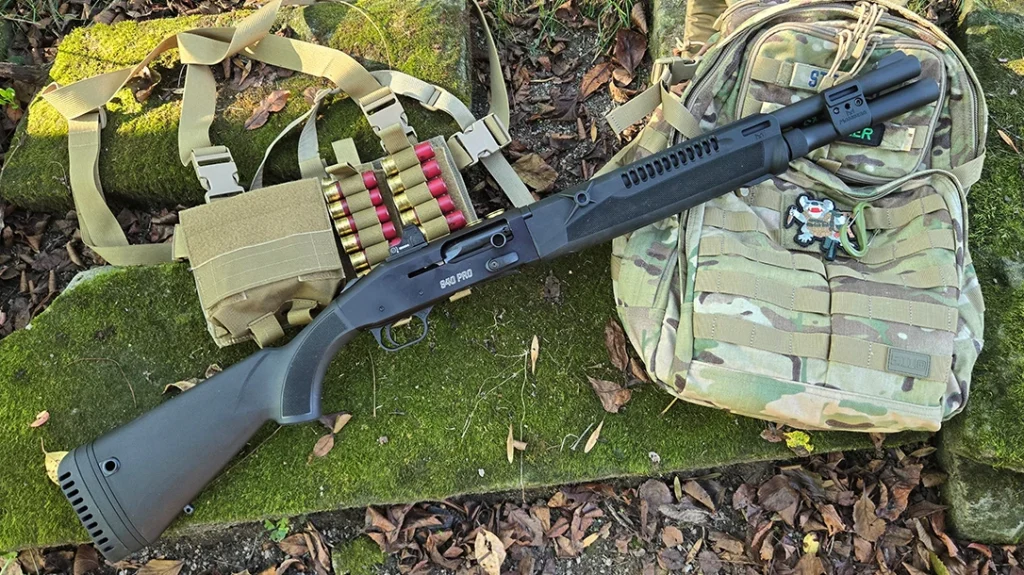If you are old enough to remember the name Semmerling, a manually operated subcompact .45 ACP “semi-auto” developed in the early 1980s and marketed as the world’s smallest magazine-fed .45 ACP pistol, then you know how long it has taken to develop today’s ultra-compact M1911-style .45 ACP semi-autos—concealed carry pistols scaled down in frame, barrel, and grip dimensions to make them easier to carry without sacrificing ease of use or accuracy.
Sounds simple enough, but it is a tall order to take a gun designed a century ago as a full-size military sidearm weighing 39 ounces and scale it down to a size barely greater than a medium-frame revolver with a 4-inch barrel, an average weight of just 25 ounces and accomplish this without giving up cartridge capacity (6+1 or 7+1 rounds on board) or compromising the gun’s handling characteristics.
.45 Power
Advertisement — Continue Reading Below
Firearms technology has finally caught up with an idea that was just slightly ahead of its time back in the early 1980s—packing big firepower in a small package. And there is a good reason. With more CCW permits and greater personal vigilance, mainstream Americans have come to understand that self-defense is first and foremost about defense, and that generally means first-shot stopping power in a life-threatening confrontation. Very few cartridges in American history have proven themselves better suited to that task than the .45 ACP. Combined with the latest high-velocity defensive ammunition like CorBon 185-grain DPX and Federal Premium 230-grain Hydra-Shok LE loads, you have a compact handgun that can end an armed confrontation with one well-placed shot. In law enforcement this can be critical, but no less so in a home or self-defense situation.
New Carry Options
An ultra-compact .45 Automatic has to be large enough to handle comfortably while small enough to be that very desirable backup gun or everyday concealed carry sidearm. There are now a number of ways to have a .45 ACP with 7+1 capacity in a size that fits comfortably in an inside-the-waistband (IWB) holster, belt holster, shoulder or ankle holster.
Advertisement — Continue Reading Below
Today, Colt offers the Defender SA 1911 with 3-inch barrel and 7-round magazine, but it is only one of more than a dozen ulta-compact .45 Autos on the market that provide a carry weight (empty) of just over 1.5 pounds, a 7-round capacity, and trimmed down dimensions to make holstering a .45 ACP no more problematic than a compact 9mm or a .40 S&W.
Among leading contemporary styles are the Glock 36 with a 6+1 capacity and carry weight of 20.11 ounces; the Taurus Millennium Pro 745, tipping the scales at 20.8 ounces with a 6+1 capacity; and the Kahr PM45 at a modest 17.3 ounces but with a reduced capacity of 5+1 cartridges. Following more traditional 1911 designs and operating features are the Kimber Ultra Carry II, weighing in at 25 ounces with a 7-round capacity, Para’s 24-ounce Stealth and Slim Hawg models with 6+1 capacity, the Springfield Loaded Micro-Compact at 26 ounces and 6+1 capacity, STI’s Shadow and Escort models with a very modest carry weight of 22.8 ounces and 6+1 capacity, and the custom-crafted and Wilson Combat Ultralight Carry Compact at 26 ounces and a 7+1 cartridge capacity.
The latest addition to the field is the new Sig Sauer 1911 Ultra .45 ACP with 7+1 capacity and a carry weight of 28 ounces. Though known for its own uniquely-styled semi-autos dating back to the 1947 P210 chambered in 9mm, Sig began building its own versions of the standard Colt Government Model in 2004, followed in 2007 by a Carry model (Revolution with 4-inch barrel) and a Compact (6+1 capacity) variation. The Ultra has a shorter 3.3-inch barrel, trim profile and custom features that make it one of the more interesting choices among current .45 Auto ultra-compacts.
Advertisement — Continue Reading Below
Sig’s Answer
Like any semi-automatic pistol bearing the Sig Sauer name, the 1911 Ultra has a distinctive look with a squared, contoured slide, deep serrations, dovetailed tritium three-dot sights, extended beavertail and grip safety, and a skeletonized hammer and trigger. This is all handsomely set off by a matte stainless steel slide and alloy frame, or in an optional two-tone version (shown) with a matte black hardcoat anodized alloy frame. The Sig styling is just different enough to make the gun unsuitable for a lot of holsters that are form-fit to a 1911A1 fame and slide. There are still plenty that will fit, however.
Is the Sig a true “Ultra” compact? That depends upon your interpretation. When the chambering is .45 ACP, it is always going to be a larger gun than one designed for .40 S&W or 9mm. But for a 7+1 capacity in .45 Auto, the Sig has some pretty trim measurements, stretching only 6.8 inches long overall, 4.8 inches tall, and only slightly over an inch wide. The stainless steel seven-round magazine has a flat (flush) floorplate and witness holes on either side. If the new little Sig .45 Auto lacks any one feature it is an ambidextrous thumb safety.
Advertisement — Continue Reading Below
The grips are wide enough and deep enough to allow a firm, one-handed hold with the little finger perfectly wrapped around the bottom of the finely checkered grip frame. The thumb safety clicks on and off with ease, and the slide release requires only modest pressure to chamber the first round on reload. If the general appearance seems familiar, it is simply a function of design dynamics, i.e. size vs. capacity, barrel length, and frame requirements. Tack on special standard features like the oversized beavertail and skeletonized hammer and trigger and you have a gun that looks very similar to a Kimber Ultra Carry II, Para Slim Hawg, and Springfield Loaded
Micro-Compact .45 ACP, all of which define today’s ultra-compact category.
Ultra Test
To put the new Sig through a basic accuracy and handling test, we used hard-hitting CorBon 185-grain DPX and 160-grain DPX (with standard velocities of 1,075 feet per second [fps] and 1,050 fps, respectively). We also ran through a series using Federal Premium Law Enforcement 230-grain Hyda-Shok JHP. The Federal Premium cleared our chronograph at 780 fps average, the CorBon 185-grain at a hefty 1,007 fps and the 160-grain DPX at 980 fps. All three managed excellent groups and the balance and handling of the Sig complemented each, even with the hard recoiling 185-grain CorBon.
Advertisement — Continue Reading Below
Using a full-sized Speedwell B-27 training silhouette target, shots were fired off-hand at 1-second intervals using a Weaver stance from a distance of 15 yards (45 feet). The best group of 5 rounds measured 1.85 inches for the CorBon 185-grain, 1.75 inches with CorBon 160-grain DPX and a slightly wider 2.85 inches with Federal Premium Hydra-Shok due to one flyer, which pulled the group out from 2.25 inches in the X-ring. All hits were grouped inside the 9, 10 and X rings. Fired from a rest, the Sig would definitely print 1.25-inch groups or better from a distance of 50 feet. The short-barreled Sig has significant muzzle rise with hot loads like CorBon 185-grain DPX, which added a beat to reacquiring the target, but the CorBon was also one of the most accurate loads and that counts for something, too. Given the compact size and light weight of the Sig, it proved to be a very manageable gun with high velocity ammunition.
Trigger pull on our test gun measured a consistent 5.38 pounds. Light enough to make target shots count with a mere 0.06 inches of travel! The three-dot tritium target sights are easy to see under all lighting conditions, with the deeply channeled rear cleanly framing the dovetailed front sight.
With such a wide selection of ultra-compact 1911s to choose from today, discerning shooters have options in size and capacity, as well as price range. The new Sig Sauer 1911 Ultra illustrates just how innovative 21st century arms makers can be with an idea that is 100 years old.
Advertisement — Continue Reading Below
























